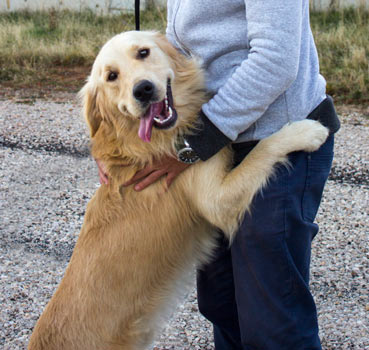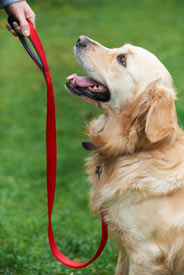How to Stop Your Dog from Jumping on People

Dogs are wonderful companions, and one of the things that is so endearing about them is how excited they get when greeting us and other people. However, we've all experienced a dog that can't contain his exuberance, jumping on us and those who come to visit. This behavior can be annoying and may even cause us injury.
Dogs love to jump on people because they know they'll get some sort of attention for it. They learn this behavior as puppies. Puppies are adorable, so naughty conduct is often seen as cute. Puppies are also small, so we're not usually hurt when they jump on us. Thus, jumping behavior is often overlooked and even rewarded by our reactions to it. This can result in an adult dog that jumps on people.
There are several ways to both prevent and correct jumping behavior. It can be prevented when your dog is a puppy through consistent guidance. It can also be corrected as an adult through redirection and obedience training.
Nothing in Life is Free
When working on training, the first thing you need to establish with your dog is the fact that he must earn everything—praise, treats, touch, and so on. If you offer these things to your dog without his earning them, he does not really appreciate them.
Your dog should perform something that you want him to do prior to eating his meals, going through a door, getting a treat, and even receiving attention. This will allow your dog to be more focused on behaving instead of getting too excited. In fact, this will carry over into every situation in his life, making him a better companion.
Default Behavior
One of the first things you should teach your dog is something simple that he can automatically perform whenever he wants something from you. This is called a default behavior.
The most useful default behavior for dogs is for them to sit. This keeps your dog from jumping up on you as you attempt to put his food dish down, keeps him more manageable at doors and gates, and prevents him from jumping up on guests when greeting them at the door.
Teaching Your Dog to Sit

Teaching your dog how to sit is done by luring him to do so, then rewarding him. It can be accompanied by clicker training. Clicker training is the process of marking the moment that your dog performs the act you are training him to do with a unique sound (the click), then rewarding him. This helps him associate the act with the reward. The reward can be food (which is a big motivator for many dogs), praise, or touch. Often, food works well in the beginning and praise or touch can be used later on. Follow the steps below to help your dog learn to sit using clicker training.
- Hold a treat right between your dog's eyes so that he must look up to see it. Don't hold it so high that he feels he must jump up to get it. A couple of inches above his head is sufficient.
- As your dog looks up at the treat, click and then give him the treat.
- Repeat this process but this time wait for your dog's rear end to lower a bit prior to clicking and rewarding.
- Finally, wait for your dog's rear end to touch the ground, then click and reward.
- Repeat this step three to five times until your dog recognizes that your hand over his head means that he should sit.
- Now you can attach a verbal cue to the action such as "Fido, Sit." Use a firm tone of voice. Give the command only once so that he identifies with that specific sound. After he sits, use a lot of enthusiastic praise as you click and then reward him.
Reinforcement of the Sit Command
You are never truly finished training your dog. Everything you teach him must be reinforced and repeated in order for him to continue to do it properly.
Now that your dog knows the meaning of the sit command, you should use it prior to giving him anything that he may want. If he comes to you for attention, do not offer any until he first sits. Prior to feeding him, make him sit. Prior to allowing him to greet anyone, including yourself, he must sit. Before going outside for a walk, he should sit as you put on his leash.
Breaking Your Dog's Jumping Habit
Should your dog already be in the habit of jumping on you or others, you can redirect him into the more appropriate sitting behavior by doing the following:
- When you are approaching your dog in a situation where he would normally jump on you, do not even look at him unless he sits. If he jumps, step away before he lands on you.
- If he does not sit on his own, tell him to sit.
- When he does sit, give him the reward of your attention.
- When your dog knows this pattern, expect him to sit without having to give him the cue first. Do not give him any attention until he sits.
This process will eventually extinguish your dog's jumping behavior without the need to inflict any kind of punishment, which is never advisable. You will simply be redirecting him into a more acceptable behavior and he will do so because it is rewarding to him. It is positive reinforcement at its best: gratifying to you and pleasing to your dog.
You May Also Like These Articles:
Disclaimer: This website is not intended to replace professional consultation, diagnosis, or treatment by a licensed veterinarian. If you require any veterinary related advice, contact your veterinarian promptly. Information at DogHealth.com is exclusively of a general reference nature. Do not disregard veterinary advice or delay treatment as a result of accessing information at this site. Just Answer is an external service not affiliated with DogHealth.com.
Notice: Ask-a-Vet is an affiliated service for those who wish to speak with a veterinary professional about their pet's specific condition. Initially, a bot will ask questions to determine the general nature of your concern. Then, you will be transferred to a human. There is a charge for the service if you choose to connect to a veterinarian. Ask-a-Vet is not manned by the staff or owners of DogHealth.com, and the advice given should not delay or replace a visit to your veterinarian.



